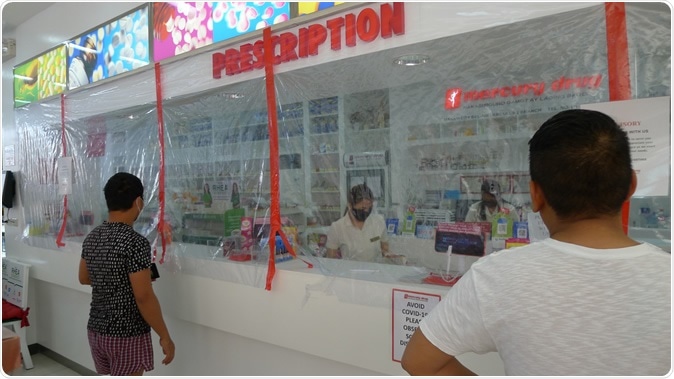The coronavirus disease (COVID-19) has dramatically affected European countries and the United States, reporting the highest number of confirmed cases. In Asia, though the number of infections gradually increases, some countries have reported high death rates, including Indonesia and the Philippines.
The outbreak of COVID-19 is a source concern in the Philippines, which has, as of April 20, reported 6,259 confirmed cases and 409 deaths, most of which are in the National Capital Region (NCR) where Manila is located. Now, a new study reveals that more impoverished cities and regions report more COVID-19 cases than those with higher incomes.

MAKATI CITY, PHILIPPINES – APRIL 05 2020: Pharmacies with improvised protective shields to address the COVID19 pandemic. Image Credit: trysterfries / Shutterstock
Uploaded on the MPRA, Munich Personal RePEc Archive, the study shows that high income or low poverty incidence is tied to significant reductions in COVID019 cases in 17 regions in the country. The findings of the study may provide valuable data to health officials and government authorities in developing targeted strategies in high-risk regions.
The study also encourages the country to formulate policies and programs to reduce poverty, to prevent further cases if COVID-19 becomes recurrent.
Poverty brings more COVID-19 cases
The study considered socio-economic profiles and how they are linked to COVID-19 cases, including poverty incidence, subsistence incidence, the magnitude of poor families, and the magnitude of subsistence-poor population. The researcher also considered other factors such as savings, income, and expenditure recorded per region in the Philippines.
Poverty incidence is the proportion of the population with per capita income less than the per capita poverty threshold. Subsistence incidence, on the other hand, is the proportion of the population with per capita income less than the per capita food threshold.
The study spanned 17 regions in the country and was linked to the number of cases as of April 7. Among the socio-economic indicators considered in the study, four were related to COVID-19 cases. Expenditure, subsistence incidence, and poverty incidence were positively related to the disease cases per region.
The findings suggest that regions with many poor residents whose income is not adequate to meet basic food needs were most likely to report high COVID-19 cases. Further, regions that spend more funds may report a high number of cases, while regions with fewer poor Filipinos may report a lower incidence of COVID-19 cases.
“On the other hand, income was negatively correlated with COVID-2019 cases suggesting that Philippine regions with low annual accumulated income, had high cases of COVID-2019. Conversely, Philippine regions with a high annual accumulated income had most likely low cases of COVID-2019,” Mark Alipio of the Davao Doctors College, University of Southeastern Philippines wrote in the paper.
Epidemiological characteristics of COVID-19
In another study by the same researcher, along with co-author Joseph Dave Pregoner, unveiled the epidemiological characteristics of the COVID-19 pandemic in the Philippines, which is caused by the severe acute respiratory syndrome coronavirus 2 (SARS-CoV-2).

COVID-19 in The Philippines. Check point Maasin City, Southern Leyte, The Philippines. Image Credit: Pascal Canning / Shutterstock
The study focused on patients who tested positive in the country as of April 3, which were gathered from the DOH NCOV tracker and the University of the Philippines COVID-19 tracker. The researchers collated the total number of cases according to sex, age, and region in the country.
The research, which was made available online on MedRxiv, showed that the country is experiencing an extremely high infectivity rate, with a 4.51 percent fatality rate, which is lower than the previous coronavirus outbreaks, the severe acute respiratory syndrome (SARS) and the Middle East respiratory syndrome (MERS). However, the fatality rate in the Philippines is higher compared to other Asian countries such as Singapore, Malaysia, Brunei, and Thailand. It is also higher than in other countries, such as the United States, mainland China, and Germany.
Also, the researchers found that a majority of the confirmed cases were males, older adults, and those living in the Metro Manila region. Males, the elderly, and those living in the Ilocos region were most likely to die from COVID-19.
In another paper by Mark Alipio, the mean age of deaths in the Philippines as 68.48 years, while most of the deaths were between 70 and 79 years old. Among the confirmed cases, a majority resides in Quezon City and Manila. Residents who had no exposure to a known case and no travel history are more vulnerable to death, while most deaths were linked to underlying medical conditions. Most deaths had hypertension, followed by diabetes mellitus, chronic kidney disease, acute kidney injury, asthma, and kidney disease.
Late test results
Most of the deaths reported in the country had their results released after they died, while some received the results on the day of their death. The team recommends that the government should ramp up testing of suspected individuals tp reduce mortality cases.
“Adherence to infection control guidelines such as but not limited to frequently handwashing for at least 20 seconds, observing coughing etiquette, wearing of masks, and social distancing should be maintained to contain the disease, thereby decreasing the number of cases while increasing the rate of recovery which ultimately will flatten the epidemiological case curve,” the researchers recommended.
Important Notice
medRxiv publishes preliminary scientific reports that are not peer-reviewed and, therefore, not be regarded as conclusive, guide clinical practice/health-related behavior, or treated as established information.